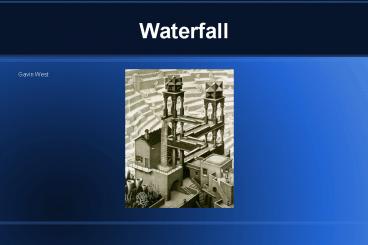Waterfall - PowerPoint PPT Presentation
1 / 12
Title:
Waterfall
Description:
Title: Introducing a New Product Author: Gavin West Description: General introduction of a new product taking customer wishes into account Last modified by – PowerPoint PPT presentation
Number of Views:102
Avg rating:3.0/5.0
Title: Waterfall
1
Waterfall
- Gavin West
2
Background Info Published 1961 Artist M.C.
Esher
3
(No Transcript)
4
The Basics
Upon first glance, you most notice the waterfall
and how it falls into itself. As hinted by the
title, the waterfall and it's meaning is the
primary part of this piece. Elsewhere in the
piece you see two characters, one putting out
laundry and the other lounging around.
- What is most noticeable, when you first look at
this print?
5
Intended Audience
- Who was the intended audience of this lithograph?
Being a simple artist, Escher's audience was the
entire world the work was designed for everyone
to view, something of beauty and meaning.
6
Logos
- Is the work's substance logical? What thoughts
does it bring to mind?
No, the work is not logical. It doesn't make
sense that a waterfall can fall into the same
stream that provides its water. However, this
hints toward some kind of deeper meaning in
Escher's mind when creating this lithograph.
7
Deeper Meaning?
- Being as the waterfall quite literally falls into
itself, a perpetual motion machine (something
that can create infinite energy and do infinite
work) is created which defies the Law of
Conservation of Energy. When thinking about this
and the actions of the people in the scene, what
do you think Esher was idolizing in this work?
Perpetual motion has been part of many people's
utopia dreams. The people are lounging around
because they have it made they don't have to
worry about working much (other than adding water
to the waterfall, as Escher once jokingly noted,
due to evaporation). Escher was a man of
existential thought and theory, and displayed his
thoughts on many proposals in his artworks.
8
Ethos
Yes M.C. Escher is one of the world's best
known artists, his works are often discussed in
Psychology forums (meetings) and he is regarded
as a philosopher despite having no degree or
official education in any relating subject. His
thoughts on many theories are held in high
regard.
- For the information presented, do you believe
that M.C. Escher may be considered a credible
source and that his expression correctly portrays
the intended meaning?
9
Pathos
- Is there any pathological appeal in this
lithograph?
Despite so much deeper meaning, I don't believe
that Escher actually intended for there to be
emotional appeals in this work, although they may
be inferred in certain contexts.
10
Technique
- What techniques were used in this work? What
stands out in Escher's use of shape, detail, and
overall composition?
Most notable is the three-times used Penrose
Triangle. Escher plays with the mind's
expectations of viewing 3D objects on a 2D
plane. The odd looking objects in the mid-bottom
left hand add complex detail into the work,
balancing the more detailed mid-top right. These
details help present Escher's thoughts more fully
and make a much more interesting visual for
anyone who views it. Escher also added some of
his favorite objects the polyhedrons on top of
the stream's towers.
11
Omittance
The rest of the village or city wasn't included
in the work, despite evidence of its existence.
Escher wanted to portray a singular idea of his
utopia, which wouldn't be so well emphasized by
having a large group of structures in the frame.
- What has been omitted from this slide?
12
Bibliography
- www.mcescher.com
- www.mathacademy.com/pr/minitext/escher/































